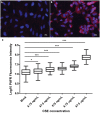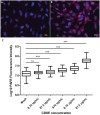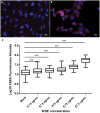A cost-effective technique for generating preservable biomass smoke extract and measuring its effect on cell receptor expression in human bronchial epithelial cells
- PMID: 32161803
- PMCID: PMC6994070
- DOI: 10.1093/biomethods/bpy010
A cost-effective technique for generating preservable biomass smoke extract and measuring its effect on cell receptor expression in human bronchial epithelial cells
Abstract
Nearly half of the world's population uses biomass fuel for the purposes of cooking and heating. Smoke derived from biomass increases the risk of the development of lung diseases, including pneumonia, chronic obstructive pulmonary disease, airway tract infections, and lung cancer. Despite the evidence linking biomass smoke exposure to pulmonary disease, only a small number of experimental studies have been conducted on the impact of biomass smoke on airway epithelial cells. This is in part due to the lack of a standard and easily accessible procedure for the preparation of biomass smoke. Here, we describe a cost-effective and reproducible method for the generation of different smoke extracts, in particular, cow dung smoke extract (CDSE) and wood smoke extract (WSE) for use in a range of biological applications. We examined the effect of the biomass smoke extracts on human bronchial epithelial cell expression of a known responder to cigarette smoke exposure (CSE), the platelet-activating factor receptor (PAFR). Similar to the treatment with CSE, we observed a dose-dependent increase in PAFR expression on human airway epithelial cells that were exposed to CDSE and WSE. This method provides biomass smoke in a re-usable form for cell and molecular bioscience studies on the pathogenesis of chronic lung disease.
Keywords: biomass smoke; chronic obstructive pulmonary disease; cigarette smoke extract; platelet-activating factor receptor.
© The Author(s) 2018. Published by Oxford University Press.
Figures





Similar articles
-
Dung biomass smoke activates inflammatory signaling pathways in human small airway epithelial cells.Am J Physiol Lung Cell Mol Physiol. 2016 Dec 1;311(6):L1222-L1233. doi: 10.1152/ajplung.00183.2016. Epub 2016 Nov 11. Am J Physiol Lung Cell Mol Physiol. 2016. PMID: 27836898 Free PMC article.
-
An antagonist of the platelet-activating factor receptor inhibits adherence of both nontypeable Haemophilus influenzae and Streptococcus pneumoniae to cultured human bronchial epithelial cells exposed to cigarette smoke.Int J Chron Obstruct Pulmon Dis. 2016 Jul 25;11:1647-55. doi: 10.2147/COPD.S108698. eCollection 2016. Int J Chron Obstruct Pulmon Dis. 2016. PMID: 27524890 Free PMC article.
-
A comparison of the inflammatory and proteolytic effects of dung biomass and cigarette smoke exposure in the lung.PLoS One. 2012;7(12):e52889. doi: 10.1371/journal.pone.0052889. Epub 2012 Dec 20. PLoS One. 2012. PMID: 23285217 Free PMC article.
-
Exposure to biomass smoke as a cause for airway disease in women and children.Curr Opin Allergy Clin Immunol. 2012 Feb;12(1):82-90. doi: 10.1097/ACI.0b013e32834ecb65. Curr Opin Allergy Clin Immunol. 2012. PMID: 22157154 Review.
-
Pathogenic mechanisms in chronic obstructive pulmonary disease due to biomass smoke exposure.Arch Bronconeumol. 2015 Jun;51(6):285-92. doi: 10.1016/j.arbres.2014.10.005. Epub 2015 Jan 20. Arch Bronconeumol. 2015. PMID: 25614376 Review. English, Spanish.
Cited by
-
The role of environmental exposure to non-cigarette smoke in lung disease.Clin Transl Med. 2018 Dec 5;7(1):39. doi: 10.1186/s40169-018-0217-2. Clin Transl Med. 2018. PMID: 30515602 Free PMC article. Review.
References
-
- World Health Organisation. Household Air Pollution and Health Fact Sheet Number 292 Updated in February 2016: World Health Organisation 2016http://www.who.int/mediacentre/factsheets/fs292/en/.
-
- Assad NA, Balmes J, Mehta S. et al. Chronic obstructive pulmonary disease secondary to household air pollution. Semin Respir Crit Care Med 2015;36:408–21. - PubMed
-
- Assad NA, Kapoor V, Sood A.. Biomass smoke exposure and chronic lung disease. Curr Opin Pulm Med 2016;22:150–7. - PubMed
LinkOut - more resources
Full Text Sources
